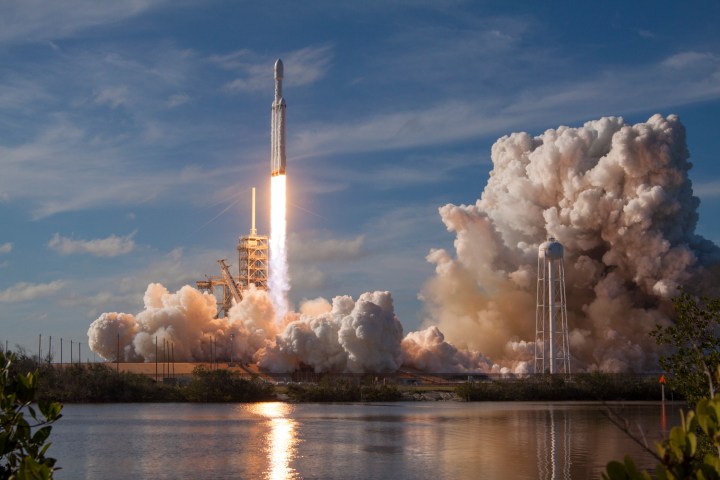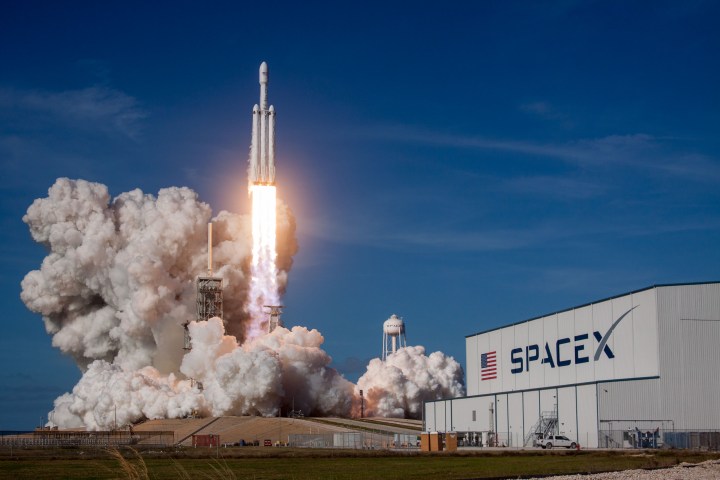It’s time for Elon Musk and his launch company, SpaceX, to shake up the world of off-planet travel once again. After a year of successful launches and recoveries of the Falcon 9 rocket’s first stages, Musk has his sights set on heavier payloads, more launches, and bigger missions — all of which will theoretically be possible with the introduction of SpaceX’s newest rocket: the Falcon Heavy. The rocket launched successfully on February 6 at approximately 3:45 PM EST … well, more or less successfully, anyway.
Here’s everything you need to know about what’s soon to be the world’s biggest, baddest rocket.
What’s the big deal?

Big is exactly the deal. When the Falcon Heavy makes its debut, it will become the world’s largest operational rocket — dwarfed only by the Saturn V rocket, which was last flown in 1973. Weighing in at 54 metric tons (119,000 pounds), the Falcon Heavy also boasts an operational payload of more than two times its closest competitor, the Delta IV Heavy, yet can be produced for just a third of the cost.
This is made possible by drawing heavily upon the proven success of the Falcon 9 rocket system, as the first stage of the Falcon Heavy is composed of three Falcon 9 engine cores. The combined 27 Merlin engines generate more than five million pounds of thrust at liftoff, equal to the power of 18 747 aircraft. (While we wait for the liftoff, here are seven more amazing facts about the Falcon Heavy.)
Why the wait?
First mentioned by Musk in 2005, and originally scheduled to become operational just a few years later, the Falcon Heavy has been in production for quite some time.
In 2011, plans were set in motion to increase manufacturing capabilities to meet expected demands of both the Falcon 9 and Falcon 9 Heavy. Then in 2015, with the introduction of the Falcon 9 V1.1 upgrades, tandem production of the Falcon Heavy was announced. This eventually culminated in a photo released in December 2016 of the Falcon Heavy interstage at the company headquarters in Hawthorne, California.
Since then, a number of different things (additional testing, the CRS-7 launch failure, and extensive launch pad renovations) have contributed to years of delays. But now, with its maiden voyage set for February 2018, business is piling up for SpaceX.
How did Falcon Heavy’s Test Launch go?

It was a success…generally speaking. As planned, Falcon Heavy launched on February 6, 2018, carrying Elon Musk’s personal Tesla Roadster. The launch was made with three rocket boosters, which detached as designed when the rocket entered orbit. The boosters were designed to descend back to earth where they could be retrieved and used again. All three boosters had pre-programmed return flights to make: Two of the boosters landed safely on the Cape Canaveral Air Force Station, but the third, due to land on the SpaceX landing pad in the Atlantic Ocean, missed its mark and crashed after the majority of its engines failed.
Still, the landing was considered an overall success, as the payload was delivered successfully into orbit without damage and most of the boosters returned to earth to be reused. The Tesla Roadster, meanwhile, was intended to travel on a trajectory toward Mars, but missed its mark and is currently planning on visiting the asteroid belt between Mars and Jupiter as a consolation prize. Reports confirm that Musk was, in fact, not in his car at the time.
What’s next for Falcon Heavy?

Let’s talk about three exciting events in the future of Falcon Heavy, and how they are playing out:
STP-2: Space Test Program-2 is a U.S. satellite mission in which Falcon Heavy will take at least two dozen satellites into orbit for launch, and a vital test of Heavy’s abilities. These satellites come from a myriad of organizations, including NASA, the U.S. Military, and multiple research groups. Currently, the STP-2 mission is slated for October 2018, but it has already been pushed back (it was originally slated for June), so the date isn’t entirely confirmed.
Arabsat-6A: Arabsat-6A is also a satellite launching project, but this launch is focused on commercial satellites, instead of satellites from military and research organizations. This launch is being managed by Riyadh, a Saudi Arabian satellite operator, and will include an unknown number of satellites. Commercial satellite numbers are more difficult to predict because of 1)private contracts and 2)commercial companies may negotiate changes in their launch plans. Viasat and the European Aviation Network, for example, switched to a different satellite launch in 2017 after the Falcon Heavy 2016 launch was put on hold for a few years. Currently, the Arabsat-6A launch is expected to happen December 2018/January 2019.
The AFSPC-52 U.S. Air Force contract: In June 2018 Falcon Heavy won a $130 million contract from the U.S. Air Force for the launch of the AFSPC-52 satellite. Falcon Heavy was in close contest with Delta 4, from United Launch Alliance, but eventually won both the important Air Force certification and the flight contract. An important caveat, however: This particularly satellite is set to launch in late 2020, and a lot can change between now and then, so this contract may be subject to changes.
Editors' Recommendations
- Watch SpaceX practice an emergency escape from its Crew Dragon capsule
- How to watch the SpaceX Dragon spacecraft depart the ISS today
- SpaceX selected to deliver cargo to NASA’s Lunar Gateway space station
- SpaceX and NASA still set for historic May mission despite coronavirus
- Today’s SpaceX Starlink launch was aborted due to engine power issue





